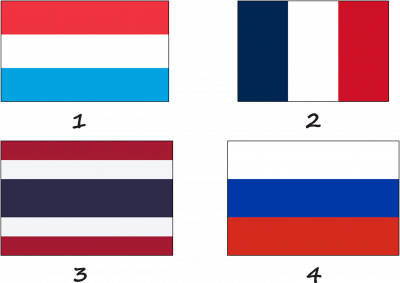The flag of the Netherlands was approved on February 19, 1937 and consists of three equal-sized stripes of red, white and blue, respectively.
The flag of the Netherlands was approved on February 19, 1937 and consists of three equal-sized stripes of red, white and blue, respectively.
There are several theories about the meaning of the red, white, and blue colors on the Dutch flag. These colors have been present on the flags and symbols of the Netherlands for centuries and have historical roots in the country's history. According to some researchers, they come from the hunting horn on the coat of arms of William of Orange. There was also a flag known as the Prinsenvlag, an orange-white-and-blue flag used during the Eighty Years' War against Spanish rule and can be considered a predecessor to the current Dutch flag.
According to the most common theory, the colors on the flag symbolize what people used to consider the "natural" composition of the population:
Other (western) countries (such as France, Croatia, and the United States) also liked this symbolism, so they used the same colors on their flags.

The top stripe has not always been red. When William I became a stakeholder in the mid-16th century, the top stripe became orange, in honor of William's surname (Van Oranje). But orange soon changed back to red. Red fabric was cheaper and easier to get than orange. In addition, the orange stripes were dyed with natural dyes from plants and faded quickly. In addition, red was easier to see in the sea. It was brighter and stood out better against the sky, waves, and sails. And since flags at that time were used mainly in shipping, red eventually became the standard color. There is also a symbolic explanation for the change of orange color. It is more associated with the royal family of Orange-Nassau. While the red, white, and blue colors are more symbolic of the Netherlands itself.
The flag of the Netherlands has three horizontal stripes: red, white and blue. During the uprising (1568-1648) against King Philip II of Spain led by the Prince of Orange, the "prince's flag" with the colors orange-blanchen-bleu was used along with a monochrome orange flag (the flag of the House of Orange-Nassau), but this is not accurate. The red, white, and blue colors were noticed in the late 16th century. It is believed that they are derived from the colors of the hunting horn in the Prince's coat of arms. Thus, there were several semi-official flags. On February 19, 1937, the red, white, and blue became the official flag of the Netherlands by royal decree. At official events, an orange pennant is additionally raised above the red, white, and blue flag.
For centuries, the Netherlands has hesitated about the color of the top stripe. Initially, it was orange, but then it was changed to red. The orange pennant was a compromise to show the connection to the royal house. The name of the royal house is also associated with the color orange. This makes the Netherlands the only country that changes its national flag in certain situations. In 1587, the Admiralty of Zealand ordered several flags in different colors for use on warships. The orange color quickly changed to red. The color of the flag's upper band became a subject of political controversy in the 1780s. When patriots and princes swore to different versions of the flag, it was eventually decided that it should consist of orange, white, and blue. Later, however, patriotic rival states banned this flag, considering it illegitimate.

The French brought the Enlightenment in 1794, which ended the use of orange in the Netherlands. Subsequently, in 1796, the General States adopted a new national flag consisting of red, white, and blue horizontal stripes. This flag became the symbol of the Kingdom of the Netherlands, proclaimed in 1806. In 1810, under the rule of Napoleon, the tricolor was replaced by the trident. After the expulsion of the French in 1813, the Netherlands wanted to bring back the orange color again. But King William I kept the flag red, white, and blue. Already in 1923, it was proposed to return the orange color, but the disputes over this lasted for years. In 1937, a decree was signed stating that red, white, and blue were the colors of the flag of the Kingdom of the Netherlands. During the Nazi occupation, flags were banned and their display was prohibited, but after the war, the red, white, and blue colors were officially adopted as the national flag.